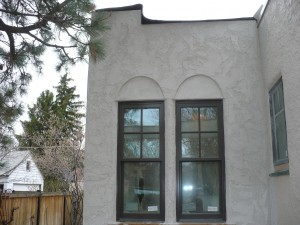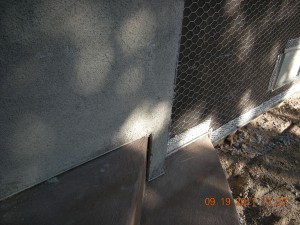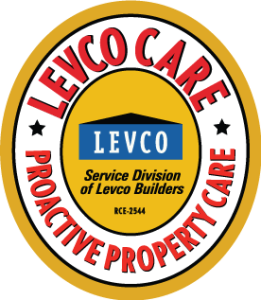Estimated reading time: 4 minutes, 39 seconds

Plaster describes the earliest interior coatings. It is a Greek term meaning to “daub on” and it dates back to 500 BCE. It was not until the invention of Portland Cement that exterior plastering, then called Stucco, was developed that could withstand the elements. A man named Joseph Aspdin, a bricklayer in Leeds, England, invented Portland Cement in his kitchen in 1824, when he cooked a mixture of lime and clay together. He named the product Portland cement because it looked similar to a stone he had seen on the Isle of Portland off the British Coast.
What is stucco?
Stucco is essentially vertical cement on a building. It is strong and lasts a very long time. Stucco is prone to cracking from many reasons but is patchable and repairable. According to the Stucco Manufacturers Association, who has a statement on stucco cracking they are a normal part of the process. That being said, cracks are the most common failure we see. In our dry climate this rarely causes issues. When we do find problems, it is from water seeping behind the stucco and causing all sorts of moisture related issues.

While remodeling in Boise Idaho we have run into many situations where stucco was either present and required patching or adding on. That which has never been painted is easier to work with. Achieving an identical look is nearly impossible but we are not afraid to try. Bottom line is that once the entire project is put back together, patches are rarely the focus of attention and blend into the big picture. In any regard, patching requires the skill and attention of a specialist. This is where our Stucco Contractor Roger Purcell comes into the picture.
Are there other types of stucco?
Turns out there are several types of stucco products. The system we use is the cementitious one that is not much different than what Mr. Aspdin invented. We start with a well attached sheathing and attach a water resistant barrier, in this case a 60 minute Plaster Craft tar paper with staples was used. Metal lath and chicken wire are applied with pneumatic staples too. The mesh is pulled away from the structure slightly so it will be in the middle of the first coat AKA Scratch Coat. The edges are treated with all sorts of specialty webbed metal pieces until the process is ready to be coated.

Then a mixture of Lime, Portland Cement, and Sand which is carefully blended on site is applied with trowels that clings to the house and the metal. This is called a scratch coat. It is roughed up and left to dry and crack as much as possible. In some areas a three coat system, the second being the Brown Coat is used but this takes additional time and is essentially an extra step that they can skip. According to Rodger the three layer process is rarely used any longer .
The next coat is the Top Coat, this is also where the texture is added. It is also a mixture of Lime, Portland Cement, Sand and possibly other materials to achieve a look. In our case we are adding paint color in it to finish out the process. In most situations the stucco is painted after the top coat has time to dry. The art is in the application and blending. Much of the texture is provided in the top coat product but it still requires the masters touch to make it right.
The other stucco looking product is known as Exterior Insulating Finishing System or EIFS. It is often refereed to as Synthetic Stucco and can have that look but it is not Portland Cement Plaster. It was developed in post world war II Europe and involves cladding with foam sheets that are reinforced with mesh (often fiberglass impregnated), then coated with a top coat that mimics stucco.
In our area this system is used frequently on commercial buildings. It has had issues with moisture penetration and failures over the years which the manufacturers blame on the contractors. Roger agrees with the manufacturers of EFIS who say their product is superior and says “Since the horrific failures of EFIS in several parts of the country, insurance companies won’t insure contractors to install it”. “Rather they will but it is cost prohibitive” Roger installed EFIS for years without any issues.
Dryvit is a name brand of a material manufacturer they are also involved in the EIFS system. They boasts about the Green aspects of added exterior insulation system. I have not seen a residential application but I am told that they are out there.
We can handle your stucco home and anything that you might need to repair stucco problems. Whether creating an addition or or replacing windows in a stucco home, Levco has you covered. Here is an industry link to more information than you ever wanted to know about stucco.
Your comments are welcome. To ask questions or get more information about remodeling, click here to email me directly, or call 208-947-7261
If you or someone you know is considering remodeling or just wants to speak to a trustworthy remodeling contractor please contact me, you’ll be glad you did.


Thanks for going over the specifics of stucco. I’ve worked with some other projects in the past, but I’ve started looking at stucco lately and I’ve been interested in how exactly it all works, especially the different layers and how it’s colored. Thanks to your post, now I know better what I’m getting myself into. Thanks for sharing!
Stewart, I appreciate your comments, This site is full of helpful information that people use regularly. Thank you for taking the time to let me know it was helpful. It only encourages me to write more!
Stucco is vertical cement on a building, It is strong and lasts a very long time. Your blog is very interactive and knowledgeable. I like it so much. I think I need to subscribe it and make the most use of it by reading it regularly and keeping myself updated.
As an expert, our service can apply the plaster manually or by using a machine for stucco repair. It is used for siding, or to cover concrete, cinder block, clay brick, or adobe.
Thanks, Brad, If you are in Auburn Washington (Near Seattle Washington) these guys look like they have a good handle on the Stucco Repair service side.